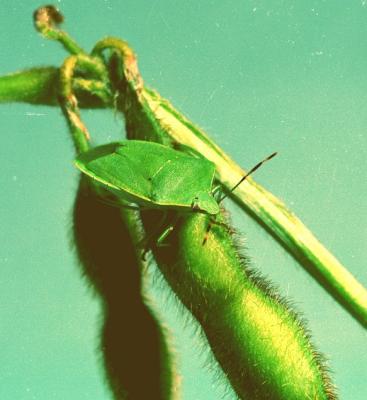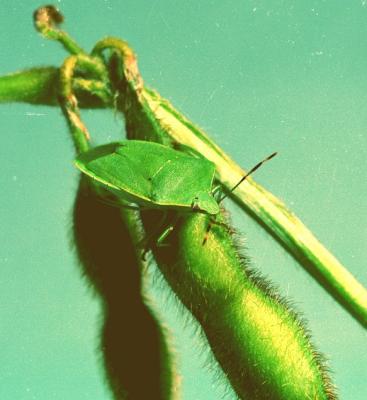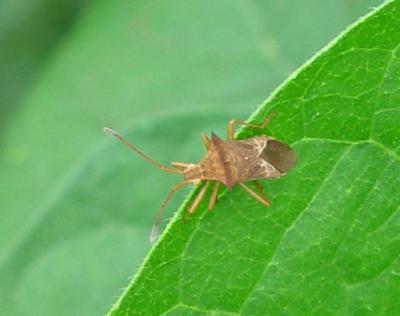



Bugs
Sucking bugs are major soybean pests. They feed on pods and soft growing plant parts. While feeding they inject toxins into pods/seeds causing necrosis.
The most important are stink bugs (e.g. Nezara viridula, and Piezodorus hybneri), Riptortus bugs (Riptortus dentipes), Mirperus jaculus, giant coreid bugs (Anoplocnemis curvipes), and spiny brown bugs (Clavigralla spp.).
Extensive stink bugs feeding may result in pod abortion and the destruction of seeds. Severe pod abortion may induce such plants to remain in the vegetative stage, causing foliar retention, which poses problems at harvest. Thegreen stink bug (Nezara viridula) also injects a fungus (Nematospora coryli) into the developing seeds, which is the casual agent of the yeast spot disease. A single stink bug puncture may result in the loss of seed germination. Direct pod and seed injury may result in yield loss and decrease in seed quality due to microorganisms, even if plants compensate for considerable injury that occurs during early pod-set. Damage at the end of the seed- development will result in yield loss.
Sucking bugs are difficult to control since they are very mobile and can infest the crop from neighbouring crops.
- Sucking bugs are attacked by parasitic wasps and assassin bugs. In Ghana, a threshold of 2-3 bugs/metre row is suggested.
- Control strategies should be related to the stage of pod development. It has been shown that early pod fill is the most sensitive stage to attack by green stink bugs (N. viridula), and the only one in which yield, seed weight and oil content was significantly reduced. Bugs should be controlled before this stage is reached, i.e. towards the end of pod elongation. Once pod fill is completed, soybeans are not at risk and control is not warranted unless planting seed or edible seed is being grown (CABI, 2005).
- Research in Indonesia has shown that Sesbania rostrata is an effective trap crop, for managing stink bugs and Riptortus bugs on soybeans (Naito, 1981, 1996). Sesbania rostrata is taller than soybean, and since it takes longer to mature, it can also attract stink bugs over a longer period. In addition to attracting adults of N. viridula, it helps to reduce their numbers, since it is not a suitable food plant for nymphal development. Sesbania is usually planted on two opposite sides of a soybean field.
- Spraying with aromatic plants (e.g. gums, lantana, khaki weed,etc.) has been suggested to repel bugs (Elwell and Mass, 1995).
- Neem-based pesticides reportedly reduce feeding by green shield bugs.
